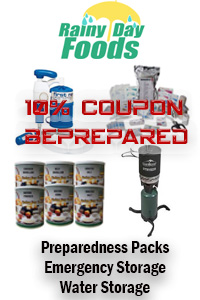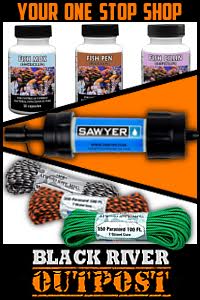By The Maj
Odds are you have already considered fishing as a means of providing food post SHTF. I would bet that many of you reading this have some type of fishing equipment incorporated into your bugout bag or long term prepping stock piles. Unless you plan to bugout or bugin in some of the more arid parts of the world, there is a good chance that you will find yourself surrounded by plenty of surface water and more often than not, that surface water contains fish. If you have not already done so in your area assessments, take a look at the most likely areas that you plan to bugout to or the area around where you live and scan for surface water. Along with the many lakes and rivers that you are already aware of, there will also be many small ponds and most of those ponds will be stocked with fish.
Typically, a pond can provide 200-300 pounds of fish, per acre, per year when properly managed. Post SHTF, I doubt many ponds will be properly managed but it is reasonable to expect that a typical stocked pond will continue to provide over 100 pounds of fish per year. It will vary according to the species of fish but on average, one pound of fish provides 400 calories, 6 to 7 grams of fat, 150 to 200 mg Potassium, and 80 to 90 grams of protein. Streams, rivers, and large lakes will vary on what they provide per acre, but will still remain a resource which you probably can rely on in a long term survival situation to supplement your food supply and daily caloric intake.
No offense to anyone reading this but if you have a pill bottle full of hooks and fishing supplies, or a little plastic case, or one of those ready made emergency fishing kits and have never been fishing in your life, don’t expect the task of catching fish to be all that easy. I do believe it is important to have some supplies readily available with which to catch fish but it is also just as important to know what type of fish you are most likely to encounter AND how to catch them. Research the area(s) and build your survival fishing kit based on the most plentiful species of fish you can expect to catch. As a general rule of thumb, smaller hooks can catch bigger fish but bigger hooks do not work so well for smaller fish. Also, if you have one of those ready made survival fishing kits, take a look at the materials in the kit. In most instances, you will find that the fishing line is of suspect quality and the hooks are not all that great. Just a word of caution but it is not something you want to find out that is lacking post SHTF.
Outside of sitting on the bank with a lined pole trying to catch fish, there are a whole host of other techniques for catching fish that do not require your undivided attention. Many of these techniques will allow you to set them, go about your other daily chores, and go back and check them later in the day or first thing in the morning. While sitting there with pole in hand might be a welcome break from the post SHTF world, time management will deem that you develop the ability to multi-task like never before.
Set hooks have been utilized for years to catch fish. The typical configuration of a set hook is a line (the inside of 550 cord works well), hook, sinker, and bait. The line will be tied off to a branch that overhangs the water and its length is adjusted according to the approximate depth of the water. The hook can be baited with worms, grubs, animal liver, fish, etc. The set hook works well for most bottom feeding fish, like catfish, but can also catch all other species of fish and turtles. Make certain that your anchor branch is sturdy enough to hold the fish until you get back but limber enough to give the fish some play. Do not expect to set one hook and bring home one fish. Set hooks should be treated like traps and snares, the more you set out, the more likely you are to be successful.
Trot Lines are similar to set hooks but typically consist of a long line (top line) with short lines spaced evenly along the long line with each short line having a hook. The hooks are baited just like set hooks are but the trot line will have twenty to fifty hooks on short lines and allow you to cover more area. The ends of the long line are secured to a sturdy tree or other tie off point at each side of the body of water you are attempting to harvest fish. Trot Lines work best when you have access to a boat, which will allow you to “run” and re-bait the hooks without having to pull the line from the water. However, if you do not have access to a boat, you can attach one end of the long line to a weight (brick, stone, heavy piece of steel) and throw the long line into the water. This technique works better with shorter Trot Lines and when you are checking the line you simply pull it in from the anchor point.
Fish traps can be fashioned utilizing metal wire and natural materials. The basic premise of a fish trap is that it is fashioned similar to a basket with a bait/attractant in the center and a necked down opening that allows the fish to enter the trap but not easily exit. There are numerous options and configurations for various types of fish traps and they range from rather “high tech” to rudimentary in their construction. Generally, these traps work great and produce more fish than set hooks or trot lines. However, they are also better suited for bug in or stationary situations where you will remain in place for longer periods of time because of their lack of portability. If you are interested in fish traps, there is a whole host of information available on their construction and implementation.
Nets present another option for acquiring fish in a survival situation. There are numerous kinds of nets out there ranging from cast nets to rather large gill nets. They can be utilized as stationary “traps” in running water, as a seine to corral fish, or as a thrown net for catching smaller fish. If your location is close to a large stream or small river, then a small gill net will probably provide you with better options for netting fish but the type of net that will work best for you will depend on the resources which are around you. I have utilized a survival gill net in a private pond and it works well as a seine and a stationary trap. This type of net packs well and can be incorporated into a bugout bag.
As with any other survival technique, there are several other means of acquiring fish which include spear fishing, bow fishing, and muddying or poisoning the waters. These methods work and if you do not like any of the other options presented, you can research and determine which option works best for you in your own unique situation. However, before you go out and test any of these methods, check the local game laws in your area and make certain the technique is legal and you have the proper licenses or permits in hand. In most States, it is illegal to net or trap freshwater fish but game laws normally do not apply to private ponds if you have the landowner’s permission.









1 comment
1 ping
Fishing could bring you good protein. You could keep some fishing line and some hooks. I would take a little bottle of power bait or some worms in a small worm farm that I could create.
[…] Survival fishing doesn’t have to mean going out and buying a $1000 fishing pole and top-of-the-line gear. In fact, sometimes using the most “boring” items can turn into the invention of a fun, effective way to catch supper. […]